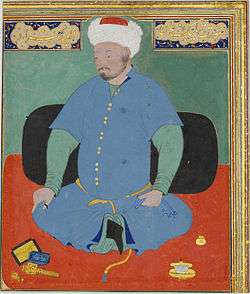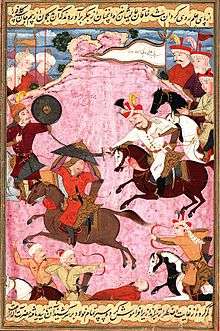Muhammad Shaybani
Muhammad Shaybani Khan (Uzbek: Muhammad Shayboniy[1], also known as Abul-Fath Shaybani Khan or Shayabak Khan or Shahi Beg Khan, originally named "Shibägh", which means "wormwood" or "obsidian") (c. 1451 – 2 December 1510), was an Uzbek leader who consolidated various Uzbek tribes and laid the foundations for their ascendance in Transoxiana and the establishment of the Khanate of Bukhara. He was a Shaybanid or descendant of Shiban (or Shayban), the fifth son of Jochi, Genghis Khan's eldest son. His father was Sheikh Haidar, son of Abu'l-Khayr Khan.
| Muhammad Shaybani محمد شیبانی | |||||
|---|---|---|---|---|---|
 | |||||
| Predecessor | Sheikh Haidar | ||||
| Successor | Jan Wafa Mirza | ||||
| Born | 1451 Central Asia | ||||
| Died | 2 December 1510 (aged 58–59) Merv, Khorasan, Turkmenistan | ||||
| Spouse | Mihr Nigar Khanum Khanzada Begum Aisha Sultan Khanum Zuhra Begi Agha Khanzada Khanum | ||||
| Issue | Muhammad Temur Sultan Khurram Shah Sultan Muhammad Rahim Sultan | ||||
| |||||
| House | Shaybanids | ||||
| Dynasty | Shaybanids | ||||
| Father | Budaq Sultan | ||||
| Mother | Aq Quzi Begum | ||||
| Religion | Sunni Islam (Sufism) | ||||
Rise to Power
Shaybani was initially an Uzbek warrior leading a contingent of 3000 men in the army of the Timurid ruler of Samarkand, Sultan Ahmed Mirza under the Amir, Abdul Ali Tarkhan. However, when Ahmed Mirza went to war against Sultan Mahmud Khan, the Khan of Moghulistan, to reclaim Tashkent from him, Shaybani secretly met the Moghul Khan and agreed to betray and plunder Ahmed's army. This happened in the Battle of the Chirciq River in 1488 CE, resulting in a decisive victory for Moghulistan. Sultan Mahmud Khan gave Turkistan[2] to Shaybani as a reward. Here, however, Shaybani oppressed the local Kazakhs, resulting in a war between Moghulistan and the Kazakh Khanate. Moghulistan was defeated in this war, but Shaybani gained power among the Uzbeks. He decided to conquer Samarkand and Bukhara from Ahmed Mirza. Sultan Mahmud's subordinate emirs convinced him to aid Shaybani in doing so, and together they marched on Samarkand.[3]
Family
- Consorts
Shaybani had five consorts:
- Zuhra Begi Agha (m. 1499-1500), an Uzbeg lady and formerly a consort of Sultan Mahmud Mirza;[4]
- Mihr Nigar Khanum (m. 1500 - div. 1501), daughter of Yunus Khan and Aisan Daulat Begum, former wife of Sultan Ahmed Mirza;[4]
- Khanzada Begum (m. 1501 - div.), daughter of Umar Shaikh Mirza II and Qutlugh Nigar Khanum, and mother of Khurram Shah;[4]
- Aisha Sultan Khanum (m. 1503), daughter Mahmud Khan Chaghatai, and mother of Muhammad Rahim Sultan;[4]
- Khanzada Khanum (m. 1507), daughter of Ahmad Khan of Haji Tarkhan and Badi-ul-Jamal Begum, and former wife of Muzaffar Husayn Mirza Bayqara;[5]
- Sons
He had three sons:
- Muhammad Temur Sultan, married firstly to Mihr Sultan Khanum, daughter of Qazaq Khan Burunduq,[6] married secondly in 1500 to Sultanum Begum, daughter of Sultan Ahmed Mirza and Qatak Begum,[4] married thirdly in 1503 to Daulat Sultan Khanum, daughter of Yunus Khan and Shah Begum,[4] married fourthly in 1507 to Ruqaiya Agha, former wife of Badi' al-Zaman Mirza;[7]
- Khurram Shah Sultan - with Khanzada Begum;[4]
- Muhammad Rahim Sultan - with Aisha Sultan Khanum;[4]
Foundation of Shaybanid Dynasty
Continuing the policies of his grandfather, Abul-Khayr Khan, Shaybani ousted the Timurids from their capital Samarkand by 1500. He fought successful campaigns against the Timurid leader Babur, founder of the Mughal Empire.[8] In 1505 he recaptured Samarkand and in 1507 also took Herat, the southern capital of the Timurids. Shaybani conquered Bukhara in 1506 and established the Shaybanid Dynasty of the Khanate of Bukhara. In 1508–09, he carried out many raids northward, pillaging the land of the Kazakh Khanate. However he suffered a major defeat from Kazakhs under Kasim Khan in 1510.
Sultanov T. I., Genghis Khan and genghisids. - Moscow, 2006. P. 139
Foreign policy
Shaybani Khan maintained ties with Ottoman Empire and China. In 1503, his ambassadors arrived at the court of the Ming Empire Emperor[9]. In Alliance with the Ottoman Sultan Bayezid II (1481-1512), Shaybani Khan opposed the Safavid Shah Ismail I[10].
Death

Shah Ismail I was alarmed by Shaybani's success and moved against the Uzbeks. In the Battle of Marv (1510), Muhammad Shaybani was defeated and killed when trying to escape. Shaybani Khan's army was surrounded by Ismail's 17,000-strong army and was defeated after fierce resistance. The remnants of the army ended up dying under enemy arrows[11][12]. At the time of Shaybani's death, the Uzbeks controlled all of Transoxiana, that is, the area between the Syr Darya and Amu Darya rivers. After capturing Samarkand from Babur, Shaybani married Babur's sister, Khanzada Begum. Babur's liberty to leave Samarkand was made contingent upon his assent to this alliance. After Shaybani's death, Ismail I gave liberty to Khanzada Begum with her son and, at Babur's request, sent them to his court. For this reason Shaybani was succeeded not by a son but by an uncle, a cousin and a brother whose descendants would rule Bukhara until 1598 and Khwarizm (later named Khiva) until 1687.
From the accounts of Babur, i.e. the Baburnama, we came to know that the Shah of Persia Ismail beheaded Shaybani and had his skull turned into a bejeweled drinking goblet[13] which was drunk from when entertaining[8]; he later sent the cup to Babur as a goodwill gesture. The rest of Shaybani's body parts were either sent to various areas of the empire for display[8] or put on a spike at the main gate of Samarkand.[14]
Personality
Shaybani Khan was very fond of history in his youth. In 1475, he was specially presented with a book about the life of Alexander the Great — Iskandarnamah, written in the distant Ottoman Empire[15].
Medieval author Nisari recognized Shaybani Khan as a scholar of the holy Koran[16].
The manuscript of his philosophical and religious work "Bahru’l-huda", written in the Central Asian Turkic literary language in 1508, is in London[17]. Shaybani Khan used various works on theology when writing his essay. It contains his own views on religious issues. The author presents his own idea of the basics of Islam: repentance for sins, showing mercy, and others. Shaybani Khan shows excellent knowledge of Muslim rituals and daily duties of devout Muslims[18].
References
- Shiban Han divani. Edited Y.Karasoy. Ankara, 1998
- This probably means Turkestan (city). Needs check and clarification.
- Mirza Muhammad Haidar Dughlat. Tarikh-i-Rashidi, 1546.
- Begum, Gulbadan (1902). The History of Humayun (Humayun-Nama). Royal Asiatic Society. pp. 211–212, 223–24 250–251, 264, 289, 297.
- Babur, Emperor; Beveridge, Annette Susannah (1922). The Baburnam in English (Memoirs of Babur) - Volume 1. Luzac & Co., London. pp. 329 n. 1.
- Subtelny, Maria (August 30, 2007). Timurids in Transition: Turko-Persian Politics and Acculturation in Medieval Iran. BRILL. pp. 252. ISBN 978-9-047-42160-3.
- Balabanlilar, Lisa (January 15, 2012). Imperial Identity in Mughal Empire: Memory and Dynastic politics in Early Modern Central Asia. I. B. Tauris. p. 24. ISBN 978-1-848-85726-1.
- Holden, Edward S. (2004). The Mogul Emperors of Hindustan (1398-1707 A.D). New Delhi, India: Asian Educational Services. pp. 74–76. ISBN 81-206-1883-1.
- Chinese documents and materials on the history of East Turkestan, Central Asia and Kazakhstan of the XIV-XIX centuries. Almaty, 1994, p. 52
- Peter B. Golden. "Central Asia in World History", Oxford University Press, 2011. — p-107.
- Mukminova R. G. The Shaybanids in History of civilizations of Central Asia. Volume V. / Editors Chahryar Adle and Irfan Habib. Co-editor Karl M. Baypakov. — UNESCO publishers, 2003. — P. 36.
- The Cambridge history of Inner Asia. / Edited by Nicola di Cosmo, Allen J. Frank and Peter B. Golden. — Cambridge university press, 2009. — P. 292.
- "Medieval Persia 1040-1797". Retrieved 1 January 2015.
- Abraham Eraly (17 September 2007). Emperors Of The Peacock Throne: The Saga of the Great Moghuls. Penguin Books Limited. p. 25. ISBN 978-93-5118-093-7.
- Allworth E., The modern Uzbeks. from the fourteenth century to the present. Stanford: Hoover institution press,1990,p.53-54
- Allworth E., The modern Uzbeks. from the fourteenth century to the present. Stanford: Hoover institution press,1990,p.52
- A.J.E.Bodrogligeti, «MuÌammad Shaybænî’s Bahru’l-huda : An Early Sixteenth Century Didactic Qasida in Chagatay», Ural-Altaische Jahrbücher, vol.54 (1982), p.1
- Bodrogligeti A. J. E. Muhammed Shaybânî’s «Bahru’l- Hudâ»: An Early Sixteenth Century Didactic Qasida in Chagatay // Ural-Altaische Jahrbücher. 1982. Vol. 54. p.2
External links
| Wikimedia Commons has media related to Muhammad Shaybani. |
| Preceded by Haider Sultan |
Khan of the Uzbeks 1500–1510 |
Succeeded by Kochkunju Muhammad bin Abul-Khayr Khan |